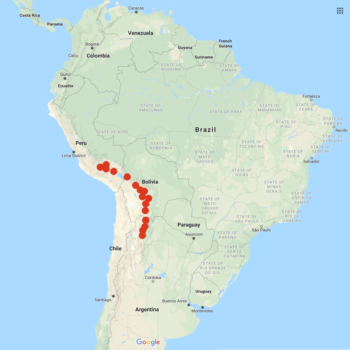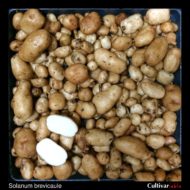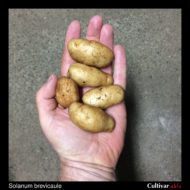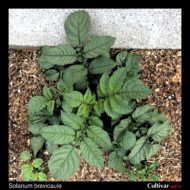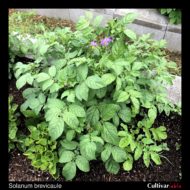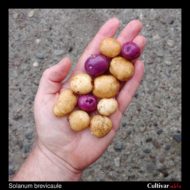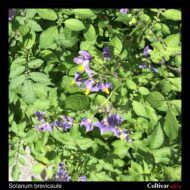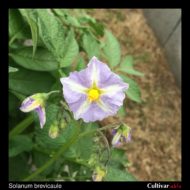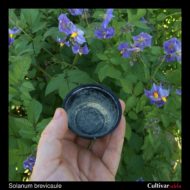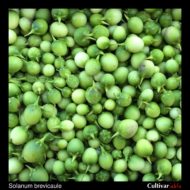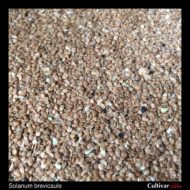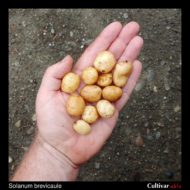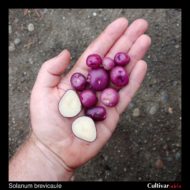Solanum brevicaule
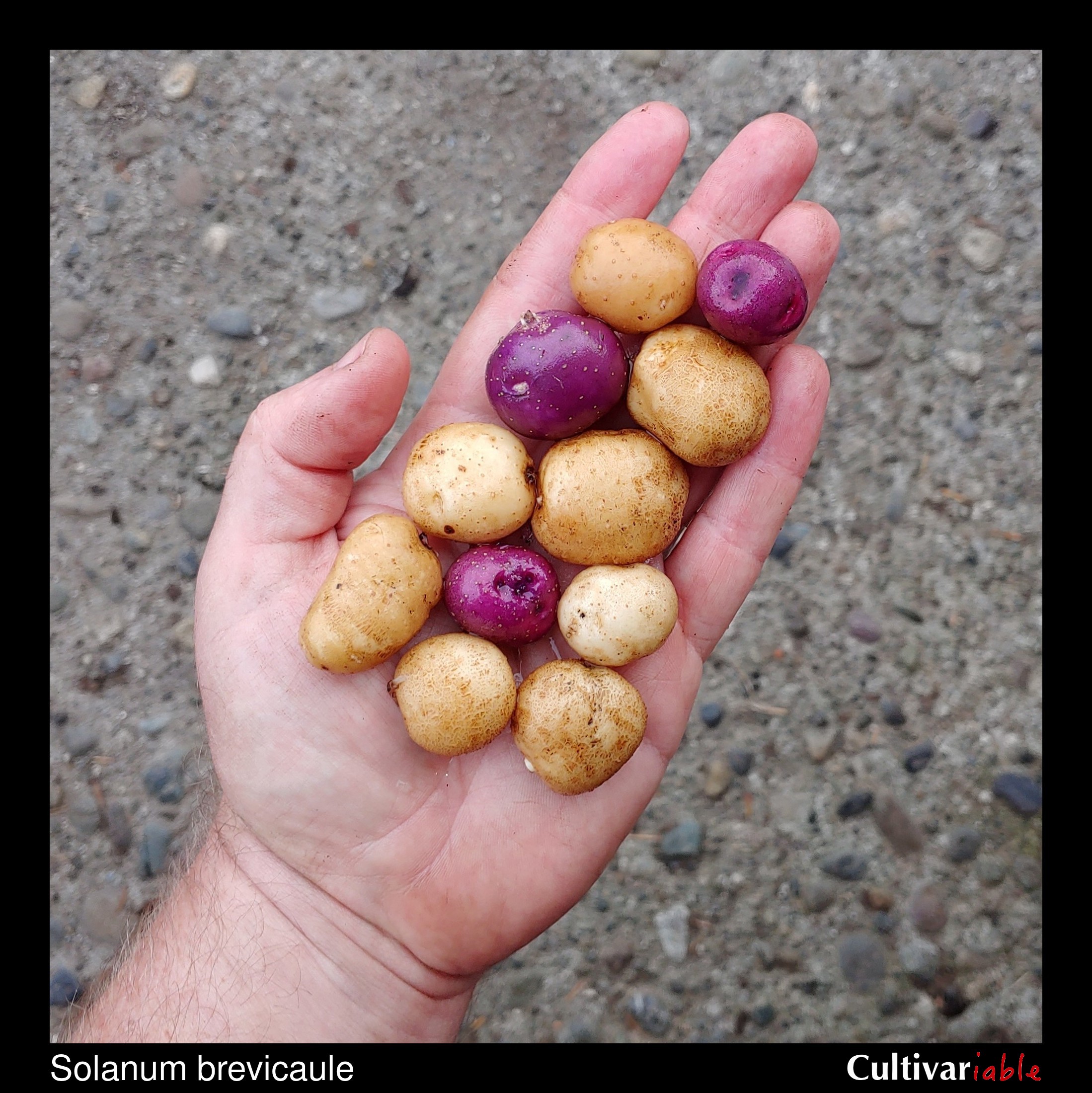
| Common Names | Achachil Ch'ogues, Alcco papa, Apharuma, Atoc papa, Catari, Charca, C’kita papa, Ckascke, Jamach’i ch’ogue, Jamppatu papa, Llutu arac, Llutu papa, Papa de Perdiz, Papa de Zorro, Piscco papa, Papa exploradora |
| Code | brc |
| Synonyms | S. alandiae, S. anomalocalyx, S. avilesii, S. boliviense subsp. virgultorum, S. brevimucronatum, S. candelarianum, S. famatinae, S. gourlayi, S. hondelmannii, S. hoopesii, S. incamayoense, S. lapazense, S. leptophyes, S. liriunianum, S. oplocense, S. pachytrichum, S. setulosistylum, S. sparsipilum, S. spegazzinii, S. subandigenum, S. sucrense, S. tuberosum subsp. sparsipilum, S. ugentii, S. vidaurrei, S. virgultorum |
| Clade | 4 |
| Series | Tuberosa |
| Ploidy | Diploid (2x), Tetraploid (4x), Hexaploid (6x) |
| EBN | 2 |
| Tuberization Photoperiod | Short Day |
| Self-compatibility | No |
| Nuclear Genome | A |
| Cytoplasmic Genome | W |
| Citation | Bitter: Repert. Spec. Nov. Regni Veg. 11:390. 1912 |
Description
Solanum brevicaule is a wild potato species found from southern Peru to central Bolivia. Plants reach about two feet tall, occasionally up to three feet. Stolons reach 3-4 feet long, perhaps as long as six feet in some cases (Ochoa 1990, as S. sparsipilum). Tubers round to ovate, one to two inches long, larger in cultivation, mostly white to tan, but I ran across one accession that produces some blue tubers. Flowers light blue to dark blue. Berries round to ovate, typically speckled. Found up to about the 13,000 foot elevation, but mostly lower. Often grows in dry environments and has good drought resistance.
The specific epithet, brevicaule, means “short stemmed.” It is formed from the Latin words “brevis,” for “short,” and “caulis,” for “stem.” While there is no completely standardized pronunciation for scientific names, the most common way to pronounce this species is probably so-LAY-num brev-ih-KAW-lay.
Solanum brevicaule is a geographically and morphologically diverse species. Boundaries between it and its nearest relatives are uncertain. Twenty species, including diploids, tetraploids, and hexaploids, are often lumped together in a “Solanum brevicaule Complex.” Van den Berg (1998) and Alvarez (2008) performed comprehensive morphological studies of the species in the S. brevicaule Complex and found little basis for division into more than three species, but inconclusive evidence even for that. The future probably holds additional taxonomic consolidation of S. brevicaule and its closest relatives.
1650 seeds per gram.
This species has been tentatively classified as lower concern on the IUCN Red List (Cadima 2014).
Resistances
Bethke (2017) scored wild potato species as a composite of seven resistance studies and S. brevicaule (as S. tarijense) ranked in second place.
A survey of markers in this species (as S. alandiae) for the late blight resistance genes R2, R8, R9, and Rpi-blb2, revealed that some plants carry all of these genes (Muratova 2019). This suggest that S. brevicaule should be a good source of late blight resistance.
This species carries a Potato Virus M resistance gene, Gm (Swiezynski 1981), on chromosome 9 (Marczewski 2006).
This species can survive frosts down to 26 degrees F (-3.5 C) (Li 1977, as S. fendleri). Vega (1995) found that this species is more frost tolerant than domesticated potato. It has a dormancy period lasting several months.
| Condition | Type | Level of Resistance | Source |
|---|---|---|---|
| Alternaria solani (Early Blight) | Fungus | Somewhat resistant | Jansky 2008 |
| Frost | Abiotic | Somewhat resistant | Machida-Hirano 2015 |
| Fusarium sambucinum (Fusarium Wilt) | Fungus | Somewhat resistant | Lynch 2003 (as S. gourlayi) |
| Globodera pallida (Pale Cyst Nematode) | Invertebrate | Somewhat resistant | Bachmann-Pfabe 2019 (under various synonyms) |
| Globodera rostochiensis (Potato Cyst/Golden Nematode) | Invertebrate | Somewhat resistant | Jackson 1988 |
| Leptinotarsa decemlineata (Colorado Potato Beetle) | Invertebrate | Somewhat resistant | Machida-Hirano 2015 (as S. gourlayi) |
| Macrosiphum euphorbiae (Potato Aphid) | Invertebrate | Not resistant to moderately resistant | Alvarez 2006 (as S. hondelmannii and S. spegazzinii) |
| Meloidogyne incognita (Root Knot Nematode) | Invertebrate | Resistant | Nirula 1967 (as S. spegazzinii) |
| Meloidogyne spp. (Root Knot Nematode) | Invertebrate | Somewhat resistant | Machida-Hirano 2015 (as S. gourlayi) |
| Myzus persicae (Green Peach Aphid) | Invertebrate | Resistant | Machida-Hirano 2015 (as S. palustre) |
| Pectobacterium carotovorum (Blackleg/Soft Rot) | Bacterium | Somewhat resistant | Chung 2011, Machida-Hirano 2015 (as S. leptophyes) |
| Phytophthora infestans (Late Blight) | Fungus | Not resistant | Gonzales 2002 |
| Phytophthora infestans (Late Blight) | Fungus | Not resistant | Bachmann-Pfabe 2019 |
| Phytophthora infestans (Late Blight) | Fungus | Somewhat resistant | Machida-Hirano 2015, Bachmann-Pfabe 2019 (under various synonyms) |
| Potato Leafroll Virus (PLRV) | Virus | Somewhat resistant | Machida-Hirano 2015 (as S. gourlayi) |
| Potato Virus M (PVM) | Virus | Somewhat resistant | Marczewski 2006 (as S. gourlayi), Dziewonska 1978 (as S. gourlayi and S. spegazzini) |
| Potato Virus X (PVX) | Virus | Resistant | Horvath 1989 (as S. alandiae) |
| Potato Virus X (PVX) | Virus | Somewhat resistant | Machida-Hirano 2015 (as S. leptophyes) |
| Potato Virus Y (PVY) | Virus | Resistant | Horvath 1989 (as S. alandiae) |
| Potato Virus Y (PVY) | Virus | Not resistant | Cai 2011 |
| Rhizoctonia solani (Black Scurf) | Fungus | Somewhat resistant | Ochoa 1990 (as S. leptophyes) |
| Tobacco Rattle Virus (TRV) | Virus | Resistant | Horvath 1989 (as S. alandiae) |
Glykoalkaloid content
S. brevicaule is probably not safe to eat, other than in very small amounts and perhaps not even then. The lines that we have grown here and tasted have dry flesh and thick, chewy skin with a strong flavor characteristic of baking potatoes, but an intensely bitter aftertaste or even a burning sensation.
Johns (1990) found glycoalkaloid levels of 23mg/100g to 164mg/100g for eight accessions of S. brevicaule (some as S. sparsipilum). The primary glycoalkaloids were solanine and chaconine. Van Gelder (1988) found TGA levels ranging from 95 to 175 mg / 100 g for S. brevicaule, 113 to 163 as S. gourlayi, 71 to 135 mg / 100g as S. leptophyes, 40 to 60 mg / 100 g as S. oplocense, 17 to 220 as S. spegazzinii, and 77 to 156 as S. sucrense. Collapsing all the synonyms gives a total range of 17 to 220 mg / 100 g. This is is a large range, with some flirting with edibility but many clearly in the danger zone.
Images
Cultivation
I have found seeds of this species easy to germinate using the standard conditions for S. tuberosum, although sometimes slow.
Due to the length of the stolons, most growers will want to contain the plants in some way. We grow wild potatoes with long stolons in buried fabric pots, which prevents them from getting out of control. A 5 gallon fabric pot works well for most wild potatoes.
The USDA Potato Genebank has observed that some accessions of this species are dependent upon GA3 for germination (Bamberg 1999).
Bamberg (2017) found a 86% increase in seed set in this species with supplemental applications of liquid fertilizer at four and seven weeks after potting.
Trapero-Mozos (2018) determined that this species will tolerate a temperature of 40 C even without prior acclimatization to warm temperatures (as S. leptophyes).
Breeding
Crosses with S. tuberosum
S. brevicaule was used in the breeding of the varieties Krantz (Plaisted 1989), Itasca, and Russet Nugget (Love 1999).
| Female | Male | Berry Set |
Seed Set | Germ | Ploidy | Source |
|---|---|---|---|---|---|---|
| S. brevicaule | S. tuberosum 2x | Moderate | Moderate | Ochoa 1990 | ||
| S. brevicaule | S. tuberosum 4x | None | None | Jackson (1999) | ||
| S. tuberosum | S. brevicaule | Low | Minimal | Jackson (1999) |
Crosses with other species
Jackson (1999) found 4-12% 2n pollen in varieties of this species.
| Female | Male | Berry Set |
Seed Set | Germ | Ploidy | Source |
|---|---|---|---|---|---|---|
| S. acaule | S. brevicaule | High | High | Ochoa 1990 | ||
| S. berthaultii (as S. tarijense) | S. brevicaule (as S. leptophyes) | Low | Low | Ochoa 1990 | ||
| S. boliviense (as S. megistacrolobum) | S. brevicaule (as S. leptophyes) | Yes | No | Ochoa 1990 | ||
| S. brevicaule (as S. alandiae) | S. acaule | Moderate | Moderate | Ochoa 1990 | ||
| S. brevicaule (as S. alandiae) | S. berthaultii | High | High | Ochoa 1990 | ||
| S. brevicaule (as S. alandiae) | S. boliviense | High | High | Ochoa 1990 | ||
| S. brevicaule | S. candolleanum | High | High | Ochoa 1990 | ||
| S. brevicaule (as S. alandiae) | S. chacoense | Yes | Yes | Ochoa 1990 | ||
| S. brevicaule (as S. alandiae) | S. huancabambense | High | High | Ochoa 1990 | ||
| S. brevicaule | S. infundibuliforme | Low | Low | Ochoa 1990 | ||
| S. brevicaule (as S. alandiae) | S. microdontum | Low | Low | Ochoa 1990 | ||
| S. brevicaule (as S. leptophyes) | S. neovavilovii | Moderate | Moderate | Ochoa 1990 | ||
| S. brevicaule | S. raphanifolium | High | High | Ochoa 1990 | ||
| S. brevicaule (as S. alandiae) | S. raquialatum | High | High | Ochoa 1990 | ||
| S. commersonii | S. brevicaule (as S. spegazzini) |
Yes | Yes | Yes | von Olah 1938 | |
| S. commersonii | S. brevicaule (as S. spegazzini) |
Yes | Yes | Yes | 2x | Propach 1940 |
| S. infundibuliforme | S. brevicaule (as S. alandiae) | Low | Low | Ochoa 1990 | ||
| S. microdontum | S. brevicaule (as S. alandiae) | Low | Low | Ochoa 1990 |
References
Solanum brevicaule at Solanaceae Source

